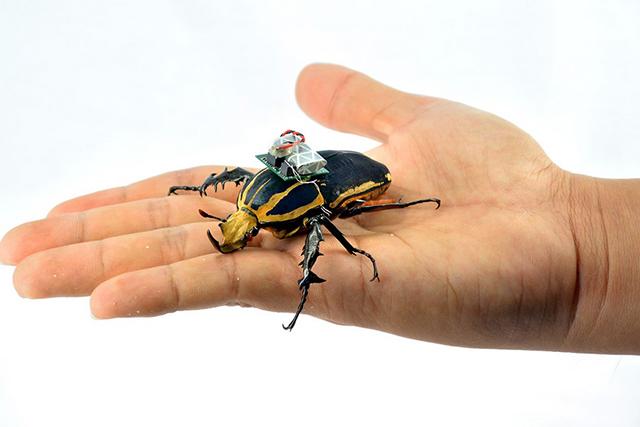 Researchers have turned beetles into cyborgs, saying that controlling real animals equipped with high-tech backpacks could offer a better alternative to remotely controlled drones.
Researchers have turned beetles into cyborgs, saying that controlling real animals equipped with high-tech backpacks could offer a better alternative to remotely controlled drones.
The invention, by a team of Singapore’s Nanyang Technological University (NTU) and the US University of California Berkeley, was featured on the cover of the latest issue of the Current Biology journal, which praised the technology as one of the journal’s best research discoveries.
“By sending a signal to the beetle, we are able to simply change its direction of movement and the beetle will manage the rest,” said Hirotaka Sato, Assistant Professor at the NTU’s School of Mechanical and Aerospace Engineering.
“This technology could prove to be an improved alternative to remote-controlled drones as it could go into areas which were not accessible before. For example, it could be used in search-and-rescue missions as it could go into small nooks and crevices in a collapsed building to locate injured survivors.”
While the researchers can effectively steer the beetle to take off, turn left or right or hover by wirelessly sending impulses to the animal’s backpack as often as every millisecond, the animal can take over control of the flight when no task is required – a major advantage over mechanical drones that need constant supervision.
“Our long term vision is to show that we can remotely induce an insect to fly, control its turns when required, and then stop it when the insect reached a set location – all done repeatedly and reliably,” said Michel Maharbiz, Associate Professor at UC Berkeley’s Department of Electrical Engineering and Computer Sciences.
During the experiments described in Current Biology, the beetles were left to fly inside a closed room equipped with 3D motion capture cameras recording their every move.
The experiment was conducted using the giant flower beetle, otherwise known as mecynorrhina torquata. On average 6cm long and weighing around 8g, the insect is large enough to allow scientists to attach sensors to its body as heavy as a coin.
The researchers believe the beetle’s strength would allow it to carry relatively heavy equipment such as a small microphone or a thermal sensor that could be used in search and rescue operations.
The backpack cost some ten Singaporean dollars to build using mostly readily available components. It is fitted with a 1cm chip integrating a microprocessor and a wireless receiver.
To attach the chip onto the beetle’s back, the researchers used natural beeswax, which could be easily removed and doesn’t harm the animal.
The microprocessor is connected to the beetle’s optic lobes and flight muscles, which allows the researchers to control the beetle’s moves.
The system is powered by a 3.9V micro lithium battery providing enough power for a full day of operations.
The researchers foresee the system could one day be completely self-powered.
“In the future, the overall rig may not even use batteries,” Sato said. “It could be powered from sustainable sources such as energy scavenged from ambient radio waves.”
Although animal welfare organisations may not particularly like the concept, the team says the technology doesn’t put the insect’s life at risk and allows it to live its regular six-month adult life.
